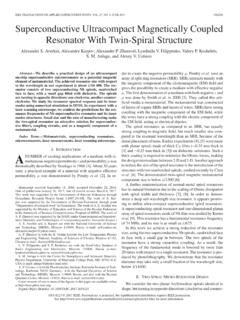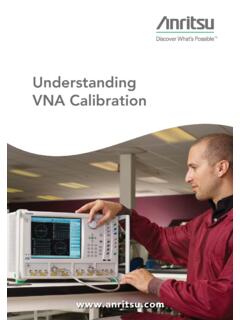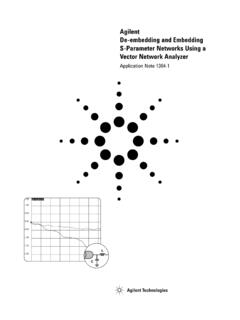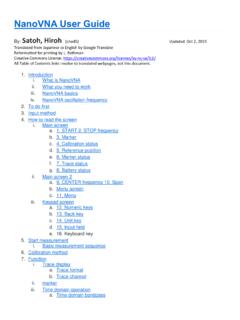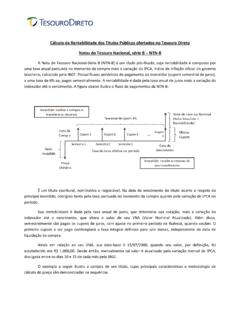Transcription of Agilent Advanced VNA Calibration - UMD
1 Modern Measurement Techniques for Testing Advanced Military Communications and Radars, 2nd Edition Agilent Technologies, Inc. 2006 M6-1 Presented by: Advanced VNA Calibration Agilent Technologies, Inc. 2006 Advanced VNA Calibration Agilent Technologies, Inc. 2006 Advanced Calibration Techniques for vector network AnalyzersWelcome to Advanced Calibration Techniques for vector network Measurement Techniques for Testing Advanced Military Communications and Radars, 2nd Edition Agilent Technologies, Inc. 2006 M6-2 Page M6- 2 Advanced VNA Calibration Agilent Technologies, Inc. 2006 Objectives Provide insight into some of the latest Calibration techniquesthat improve accuracyand make Calibration easier Look at performance improvementsusing the Advanced techniques compared to more traditional methods1-PORT Calibration PLANESU nknown thruThe objective of this seminar is to provide insight into some of the latest Calibration techniques that improve accuracy and make Calibration easier.
2 We will also look at performance improvements using the advancedtechniques compared to more traditional Measurement Techniques for Testing Advanced Military Communications and Radars, 2nd Edition Agilent Technologies, Inc. 2006 M6-3 Page M6- 3 Advanced VNA Calibration Agilent Technologies, Inc. 2006 Agenda Overview of Calibration Advanced Calibration Techniques Unknown Thru Calibration Data-Based Calibration -Standard Definitions Expanded (Weighted Least Squares) Calibration Fixture And Probe Techniques Automatic Port Extensions Embedding/De-embedding Measuring Fixtures/Probes Electronic CalibrationThe first Calibration technique we will cover is the unknown thru Measurement Techniques for Testing Advanced Military Communications and Radars, 2nd Edition Agilent Technologies, Inc.
3 2006 M6-4 Page M6- 4 Advanced VNA Calibration Agilent Technologies, Inc. 2006 What is a vector network analyzer ? vector network analyzers (VNAs).. Are stimulus-response test systems Characterize forward and reverse reflection and transmission responses (S-parameters) of RF and microwave components Quantify linear magnitude and phase Are very fast for swept measurements Provide the highest level of measurement accuracyS21S12S11S22R1R2RF SourceLOTest port 2 BATest port 1 PhaseMagnitudeDUTR eflectionTransmissionA vector network analyzer (VNA) is a precision measuring tool that tests the electrical performance of high frequency components, in the radio frequency (RF), microwave, and millimeter-wave frequency bands (we will use the generic term RF to apply to all of these frequencies). A VNA is a stimulus-response test system, composed of an RF source and multiple measurement receivers.
4 It is specifically designed to measure the forward and reverse reflection and transmission responses, or S-parameters, of RF components. S-parameters have both a magnitude and a phase component, and theycharacterize the linear performance of the DUT. While VNAs can also be used for characterizing some non-linear behavior like amplifier gain compression or intermodulation distortion, S-parameters are the primary measurement. The network analyzer hardware is optimized for speed, yielding swept measurements that are must faster than those obtained from the use of an individual source and an individual receiver like a spectrum analyzer . Through Calibration , VNAs provide the highest level of accuracy for measuring RF components. Modern Measurement Techniques for Testing Advanced Military Communications and Radars, 2nd Edition Agilent Technologies, Inc.
5 2006 M6-5 Page M6- 5 Advanced VNA Calibration Agilent Technologies, Inc. 2006 The Need for CalibrationHow do we get accuracy? With vector -error-corrected Calibration Not the same as the yearly instrument calibrationWhy do we have to calibrate? It is impossible to make perfect hardware It would be extremely difficult and expensive to make hardware good enough to entirely eliminate the need for error correctionWhat does Calibration do for us? Removes the largest contributor to measurementuncertainty: systematic errors Provides best picture of true performance of DUTS ystematic errorVNAs provide high measurement accuracy by calibrating the test system using a mathematical technique called vector error correction (this type of Calibration is different than the yearly Calibration done in a cal lab to ensure the instrument is functioning properly and meeting its published specifications for things like output power and receiver noise floor).
6 vector error correction accounts for measurement errors in the network analyzer itself, plus all of the test cables, adapters, fixtures, and/or probes that are between the analyzer and the is Calibration so important to network analysis? The reason is that it is impossible to make perfect test hardware, and too difficult and/or too expensive to make the network analyzer hardware so good that the need for error correction is entirely eliminated. vector error correction is a cost effective way to improve the performance of test systems comprised of good but not perfect hardware. The right balance between hardware performance, cost, and system performance (including error correction) must be achieved. If the RF performance of the hardware is poor, then vector error correction will not be able to overcome all the deficiencies, and the overall system performance will suffer compared to that obtained from a system using better a VNA-based test system removes the largest contributor to measurement uncertainty, which are systematic errors.
7 Systematic errors are repeatable, non-random errors that can be measured and removed mathematically. A vector -error-corrected VNA system provides the best picture of the true performance of the device under test (DUT). A network analyzer is really only as good as its Calibration , so Agilent spends a great deal of effort to provide the most complete and highest-quality choices for Measurement Techniques for Testing Advanced Military Communications and Radars, 2nd Edition Agilent Technologies, Inc. 2006 M6-6 Page M6- 6 Advanced VNA Calibration Agilent Technologies, Inc. 2006 What is vector -Error Correction? vector -error Is a process for characterizing systematic error terms Measures known electrical standards Removes effects of error terms from subsequent measurementsElectrical Can be mechanical or electronic Are often an open, short, load, and thru, but can be arbitrary impedances as wellErrorsMeasuredActualVector-error correction is the process of characterizing systematic error terms by measuring known electrical Calibration standards.
8 Any deviation from the expected results is primarily due to systematic errors in the test system. Once these errors are quantified, their effects can be mathematically removed from subsequent measurements. The error terms can be expressed as vectors since they have a magnitude and phase component. Since any test system is affected by more than one cause of measurement error, the Calibration process has to measure enoughstandards to sort out the magnitude and phase of the various electrical standards used during the Calibration process can be passive, mechanical devices, like the well-known short, open, load, and thru (SOLT) standards found in Agilent (and other) commercial Calibration kits, or they can be arbitrary known impedances that are electronically switched, as is done with Agilent s ECal electronic Calibration Measurement Techniques for Testing Advanced Military Communications and Radars, 2nd Edition Agilent Technologies, Inc.
9 2006 M6-7 Page M6- 7 Advanced VNA Calibration Agilent Technologies, Inc. 2006 Systematic Measurement ErrorsSix forward and six reverse error terms yields 12 error terms for two-port devicesSix forward and six reverse error terms yields 12 error terms for two-port devicesSourceMismatchLoadMismatchCrossta lkDirectivityDUTF requency responseOreflection tracking(A/R)Otransmission tracking(B/R)R receiverA receiverB receiverShown here are the major systematic errors associated with network - analyzer measurements. The errors relating to signal leakage are directivity and crosstalk. Directivity limits dynamic range for reflection measurements, and crosstalk limits dynamic range for transmission measurements. The errors related to signal reflections are source and load mismatch. Source mismatch errors result from interactions between the test system s source match and the input match of the DUT.
10 Load mismatch errors result from interactions between the test system s load match and the output match of the DUT. The final class of errors are related to frequency response of the receivers, and are called reflection and transmission tracking. The term tracking is used because S-parameter measurements are ratioed measurements between a test and a reference receiver. Therefore, the frequency response errors are due to imperfect tracking between the test and reference full two-port error model includes all six of these terms for the forwarddirection and the same six (with different data) in the reverse direction, for a total of twelve error terms. This is why two-port Calibration is often referred to as twelve-term error correction. These same basic error terms are also used in error models for test systems with more than two test ports, where the total number of error terms is larger than Measurement Techniques for Testing Advanced Military Communications and Radars, 2nd Edition Agilent Technologies, Inc.
